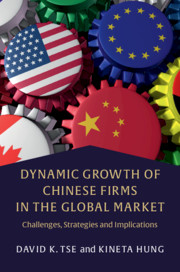Book contents
- Dynamic Growth of Chinese Firms in the Global Market
- Dynamic Growth of Chinese Firms in the Global Market
- Copyright page
- Contents
- Figures
- Tables
- 1 Introduction
- 2 China’s Economic Rise and Global Footprints of Chinese Firms
- 3 Globalisation of Chinese Firms Using Existing Paradigms
- 4 Globalisation of Chinese Firms Using New Paradigms
- 5 Challenges and Failures
- 6 Product Images and Market Acceptance of Chinese-Made Products
- 7 Corporate Social Responsibility
- 8 Managing National Image
- 9 China’s Technological Competence, Trade Relations, and Economic Co-operation
- 10 Holistic Conclusion through a Futuristic Lens
- Index
- References
2 - China’s Economic Rise and Global Footprints of Chinese Firms
Published online by Cambridge University Press: 05 February 2020
- Dynamic Growth of Chinese Firms in the Global Market
- Dynamic Growth of Chinese Firms in the Global Market
- Copyright page
- Contents
- Figures
- Tables
- 1 Introduction
- 2 China’s Economic Rise and Global Footprints of Chinese Firms
- 3 Globalisation of Chinese Firms Using Existing Paradigms
- 4 Globalisation of Chinese Firms Using New Paradigms
- 5 Challenges and Failures
- 6 Product Images and Market Acceptance of Chinese-Made Products
- 7 Corporate Social Responsibility
- 8 Managing National Image
- 9 China’s Technological Competence, Trade Relations, and Economic Co-operation
- 10 Holistic Conclusion through a Futuristic Lens
- Index
- References
Summary
This chapter begins with a summative view of China’s economic conditions before 1979 and elements of the economic reform that allowed the country to turn around and embark on decades of robust economic growth. The internal (firm-level) and institutional drivers underlying this economic miracle are delineated. In particular, it highlights two key concepts; namely, government managed growth and the institutional supremacy of state-owned enterprises (SOEs). How the SOEs in China rose from their extremely inefficient past to become global economic powers is one of the most attended phenomena in modern global economy. Their role as a key driver of economic growth is discussed along with the complementary role of China’s privately owned firms. The chapter then discusses the firms’ footprints in both developing and developed economies. It ends by examining the myths and challenges of Chinese firms going global.
Keywords
- Type
- Chapter
- Information
- Dynamic Growth of Chinese Firms in the Global MarketChallenges, Strategies and Implications, pp. 14 - 30Publisher: Cambridge University PressPrint publication year: 2020

